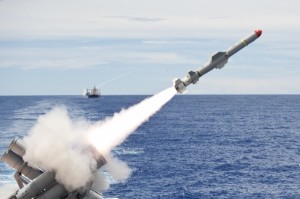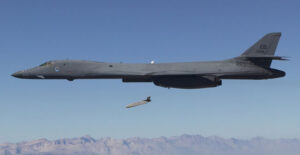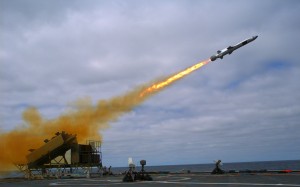Navy To Begin Arming Subs With Ship-Killer Missile
Posted on
WASHINGTON: With an eye on China, the Navy will begin arming its attack submarines with ship-killer missiles for the first time in decades. The weapon of choice: an updated model of the decades-old Harpoon.
In a little-noticed announcement posted earlier this month on a government contracting site, the Navy said it was entering into negotiations with Boeing to refurbish and recertify Harpoon anti-ship missiles for Los Angeles-class subs. It’s a major shift after decades in which submarines focused on projecting power ashore — stealthily collecting intelligence or launching Tomahawk Land-Attack Missiles (TLAMs) — with their only anti-ship weapons being their rarely-used torpedoes. Driving the change: increasing American anxiety about China’s rapidly growing military presence in the Pacific and Indian oceans.
The move comes months after a Harpoon was successfully launched from the USS Olympia submarine during the biannual RIMPAC naval exercise off the coast of Hawaii. It was the first time the missile had been fired from an American submarine since the sub-launched version of Harpoon was retired in 1997.
The test was part of a broader effort across the Navy to rebuild its surface-to- surface warfare prowess at a time when the Chinese Navy has made huge strides to modernize and expand its fleet, and Russia — to a lesser degree — is also modernizing its naval capabilities.
The effort to bring a modernized Harpoon back to the submarine fleet coincides with the delivery of the first Long Range Anti-Ship Missiles (LRASM) to operational Air Force units, a delivery announced Dec. 18. The precision-guided missile is designed to detect and destroy specific targets operating within groups of ships by identifying the target using links to drones or aircraft. An air-launched variant has been successfully tested aboard the Air Force’s B-1 bomber on a number of occasions, and it’s on schedule to achieve early operational capability on the Navy’s F/A-18 Super Hornet in 2019. Contractor Lockheed Martin has also test-fired LRASM from the same Vertical Launch System tubes used on Navy cruisers and destroyers.
Over the last handful of years, the Pentagon has made a concerted effort to get its ship-killing ability back, first under Obama’s last Defense Secretary Ash Carter and his deputy Bob Work — part of what they called the Third Offset Strategy — and under Defense Secretary Jim Mattis, whose focus on “lethality” picked up the offset effort under a new tagline.
That work is seen in the award this past May by the Navy for its next over-the-horizon ship killer to the team of Raytheon and Norway-based Kongsberg for the Naval Strike Missile program. The weapon, with a range of about 100 miles (roughly comparable to Harpoon), is destined for the Littoral Combat Ship and the future FFG(X) frigate. Initially worth $14.8 million, the contract could eventually grow to $850 million if options are exercised.
The Naval Strike Missile was also fired during RIMPAC, but not by the Navy. The Army launched NSM from the back of a truck parked at the Pacific Missile Range Facility in Hawaii, an experiment in providing land-based anti-ship firepower to support the Navy in future multi-domain operations.
There’s also an effort underway to refit surface ships with anti-ship Tomahawk missiles by 2022, some 40 years after a Tomahawk first sunk a ship in testing.
In the South China Sea, American military leadership has been particularly concerned about what the four-star commander in the Pacific called the “great wall of SAMs.” China has built in the critical waterway, having the effect of pushing Chinese offensive capabilities well out past the mainland and China’s territorial waters. The militarization of small reefs has had the practical effect of putting commercial shipping and US Navy ships in the region under threat, with the American military scrambling to come up with a response.
That response was dramatically on show during the massive RIMPAC exercise in July, during which the submarine Olympia teamed with allied forces to sink the former Newport-class amphibious ship USS Racine, which went to the bottom after absorbing an international barrage of missiles from planes, subs, ships, and even trucks.
Six Harpoons were fired from U.S. and Australian P-8 Poseidon aircraft, the Singaporean frigate RSS Tenacious, and the Olympia. The exercise was the first time Australia has fired a Harpoon from a P-8. Japan also hit the ship with truck-mounted Type 12 anti-ship missiles, while the Army hit it with its truck-mounted High Mobility Artillery Rocket System (HIMARS). Olympia delivered the coup de grace with a Mark 48 heavy torpedo.
The plan is for UGM-84 Harpoon program is to make a contract award to Boeing in 2019, with the Navy describing the work as “the refurbishment, repair, recertification, upgrade, and reissue of capsules and Encapsulated (ENCAP) Harpoon Block IC (HIC) All Up Rounds (AURs) to HIC, HIG, HII, or HII+ configurations for USN SSN-688 class submarines.”
Neither the Navy or Boeing responded to queries about the program by publication time.
Subscribe to our newsletter
Promotions, new products and sales. Directly to your inbox.




